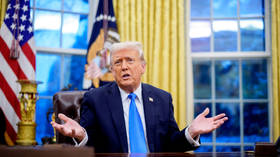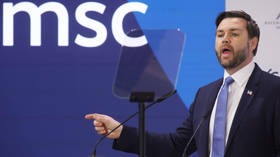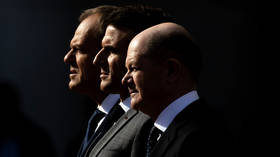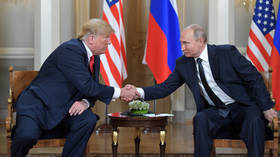
Sergey Poletaev

Sergey Poletaev is an information analyst and publicist. He specializes in Russian foreign policy and in the Russia-Ukraine conflict.
Born in 1980 in Moscow, Poletaev is a graduate of the Faculty of Journalism of Moscow State University. In 2017, together with researchers Oleg Makarov and Dmitry Stefanovich, he founded the information and analytical project Vatfor.
A Russian expert on international relations and a contributor of the Russian International Affairs Council, his articles have been published in specialist media like Russia in Global Affairs, Profile, Eurasia-Expert, and others.
Poletaev is also a facilitator/organizer of interviews, online streams on political topics, as well as scientific and workshop conferences.
Follow Sergey Poletaev’s Vatfor project on Telegram
‘Deal’ – it’s the key word in Donald Trump’s vocabulary and he’s built his career on striking them, but as he embarks on his second presidential term, he is about to face a challenge that will put his famed negotiation skills to the test. The Ukraine conflict, unlike trade deals or business arrangements, is deeply entrenched in geopolitical, military, and ideological complexities.
While Trump may initially push for a swift resolution — perhaps attempting to broker a ceasefire similar to his approach in the Middle East — he will soon realize that Ukraine is a far bigger challenge. The contradictions surrounding the conflict are not just regional but global, and a quick fix is unlikely. If Trump’s efforts fail, how will the situation evolve?
US-Western Europe: Conflict or Quiet Sabotage?
Trump’s worldview is centered around the idea that the US is losing its global dominance. Since he cannot prevent this decline, his strategy appears to be one of disruption — seizing the initiative and reshaping alliances. He has long considered NATO an outdated burden, and his demand for members to increase defense spending to 5% of GDP is, for many European countries, entirely unrealistic. Currently, only four NATO members — Poland, the US, Greece, and the UK — spend more than 2% of their GDP on defense.
Should Trump manage to overcome internal opposition and reshape US foreign policy, NATO may become his next target. The transatlantic alliance underpins many global institutions, and dismantling NATO — or significantly weakening it — would be a logical step in dismantling globalization itself. Supporting opposition parties in Europe, particularly nationalist and right-wing movements that align with his worldview, is one way he could advance this agenda.
In response, Western European elites have two options: openly confront Trump, which could lead to a transatlantic crisis, or verbally agree to his demands while quietly sabotaging them. The latter scenario is more likely. While they may nod along with Trump’s calls for increased defense spending and a tougher stance on China, in practice, European governments are unlikely to follow through. Under Trump’s leadership, NATO could lose both its political influence and its aura of invincibility.
Trump’s Ukraine Plan: Reality Check Incoming
Trump’s team is eager to pressure Ukraine’s Vladimir Zelensky into accepting a ceasefire. However, his vision for peace is simplistic and detached from reality. The war in Ukraine is not just a local conflict — it is a battleground for larger global struggles.
The first step for Trump will be to push Zelensky toward a truce, though it remains unclear whether the Ukrainian leader would agree. More likely, Trump will pressure Kiev into lowering the military conscription age to ensure a continued supply of soldiers — just as was done last year in exchange for Western military aid.
Zelensky, however, has his own concerns. He is desperately seeking security guarantees from the West, particularly from Trump. Without such assurances, he knows that if a ceasefire is reached, he will be left alone to face Russia. So far, there is no indication that Trump is willing to provide these guarantees. If he distances the US from Ukraine, Zelensky will be in an extremely vulnerable position.
Ukraine: Western Europe’s Unwanted Burden
If Trump gives up on Ukraine, Western Europe may be forced to take responsibility for the war effort. However, the European Union lacks both the military stockpiles and the industrial capacity to sustain the Ukrainian Armed Forces. Financially, the EU could seize frozen Russian assets to fund Ukraine, but it is unclear how long that strategy could last.
Trump’s ideal scenario is simple: Western Europe buys weapons from the US and sends them to Ukraine. Whether this plan will work remains to be seen. The longer the conflict drags on, the more toxic the issue becomes within European politics, with public opposition growing. If Trump and EU bureaucrats clash, Ukraine may find itself abandoned.
Russia and the rest of Europe: No Grounds for Negotiation
Unlike with the US, Russia sees no potential for negotiation with the current Western European leadership. The EU has shown no willingness to engage in meaningful diplomacy, preferring to churn out endless sanctions. Moscow’s only real option is to build relationships with non-establishment political forces in Europe — leaders like Hungarian Prime Minister Viktor Orbán or Slovak Prime Minister Robert Fico, who prioritize national interests over Brussels’ agenda. If the EU continues its current trajectory, more such leaders will emerge.
Russia and the US: The Only Negotiation That Matters
The most important diplomatic developments will take place between Moscow and Washington. Trump’s immediate goal will be to resolve the Ukraine conflict quickly, casting himself as the president who ended an unwinnable war. He can still blame Biden for the US failure in Ukraine, but the longer the conflict continues, the more responsibility he will bear.
For Russia, the time for serious negotiations has not yet arrived. Putin’s primary goal is a decisive military victory that dismantles Ukraine’s ability to resist. With Ukraine preparing for a last-ditch spring-summer offensive, the fighting will continue for at least a few more months. During that time, the war will become Trump’s problem, not Biden’s.
At that point, Washington will face a crucial decision: escalate further, potentially triggering a direct confrontation with Russia, or accept defeat. Trump, who is more focused on a potential conflict with China, seems unwilling to risk war with Moscow.
If this writer were preparing for negotiations with Trump, the message would be clear:
“Donald, your hand is weak. Ukraine will lose, and you know it. In six months, the failure will be on your shoulders, and you’ll have to decide whether to start a nuclear war — something you don’t want. You should cut your losses while you still can. No, we won’t trade Ukraine for China or anything else. We’re prepared to wait until you have nothing left to bargain with.”
Ukraine, NATO, and the Bigger Picture
The only real path to peace in Ukraine is its capitulation and the dismantling of anti-Russian nationalism. This requires a decisive military defeat, something the Russian army has been working toward for three years. If Ukraine’s military collapses, a coup in Kiev could become a real possibility.
Meanwhile, the NATO alliance faces a reckoning. Eastern European nations have long assumed that even informal NATO ties guarantee absolute protection from Russia. Ukraine’s fate will shatter this illusion. A Ukrainian defeat would mark the end of NATO expansion and shake Western influence in the region. Potential NATO candidates will see Ukraine as a cautionary tale.
Looking Ahead
If Trump’s efforts to resolve the Ukraine conflict fail, he will have three options: escalate, withdraw, or shift the burden to Europe. None of these choices will resolve the underlying issues, but they will shape the future of NATO, the EU, and the broader international order. Meanwhile, Russia will remain patient, waiting for the moment when the West is forced to acknowledge the new geopolitical reality.
As for what happens next — whether the conflict expands, shifts to new regions like the Baltics, or fades into a prolonged stalemate — only time will tell. One thing is certain: Trump’s path to a ‘deal’ on Ukraine will be far more complicated than he initially thought.
Counter Information publish all articles following the Creative Commons rule creative commons. If you don't want your article to appear in this blog email me and I will remove it asap.






















No comments:
Post a Comment